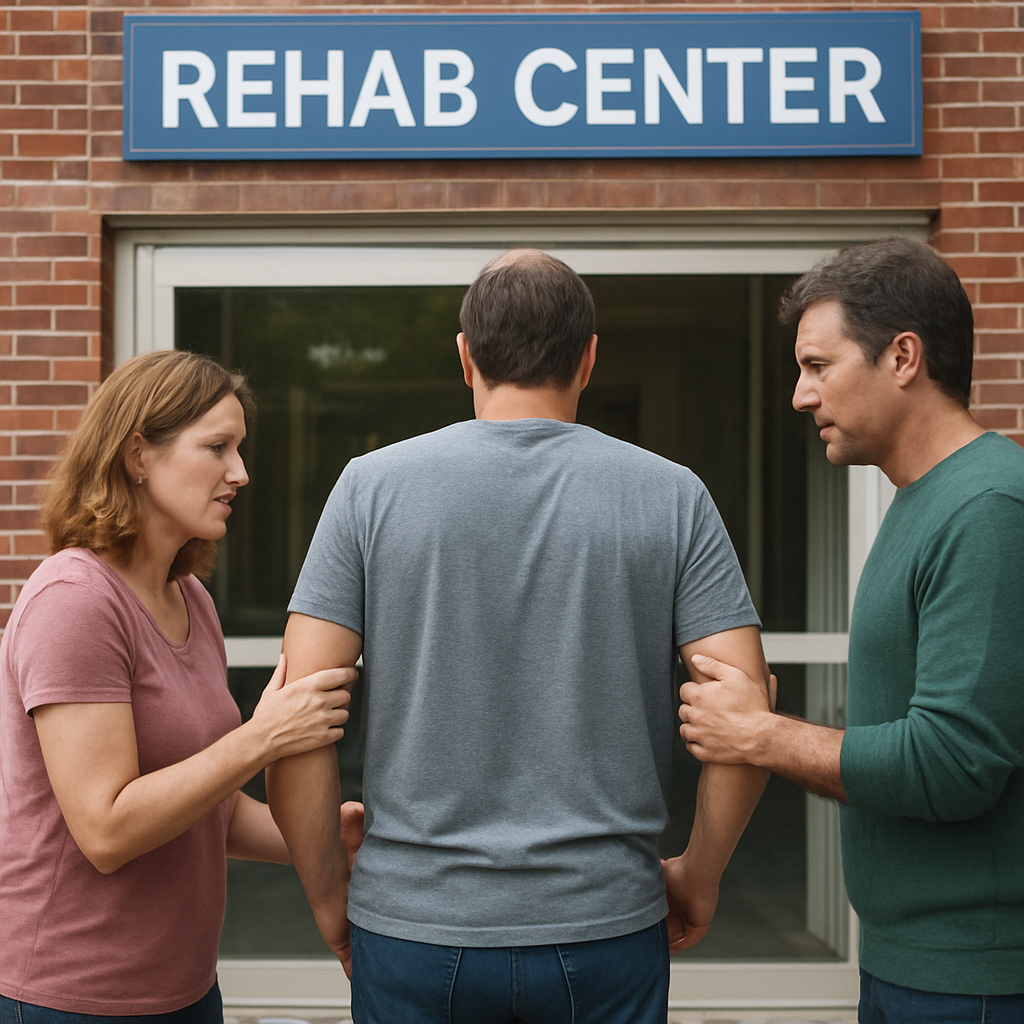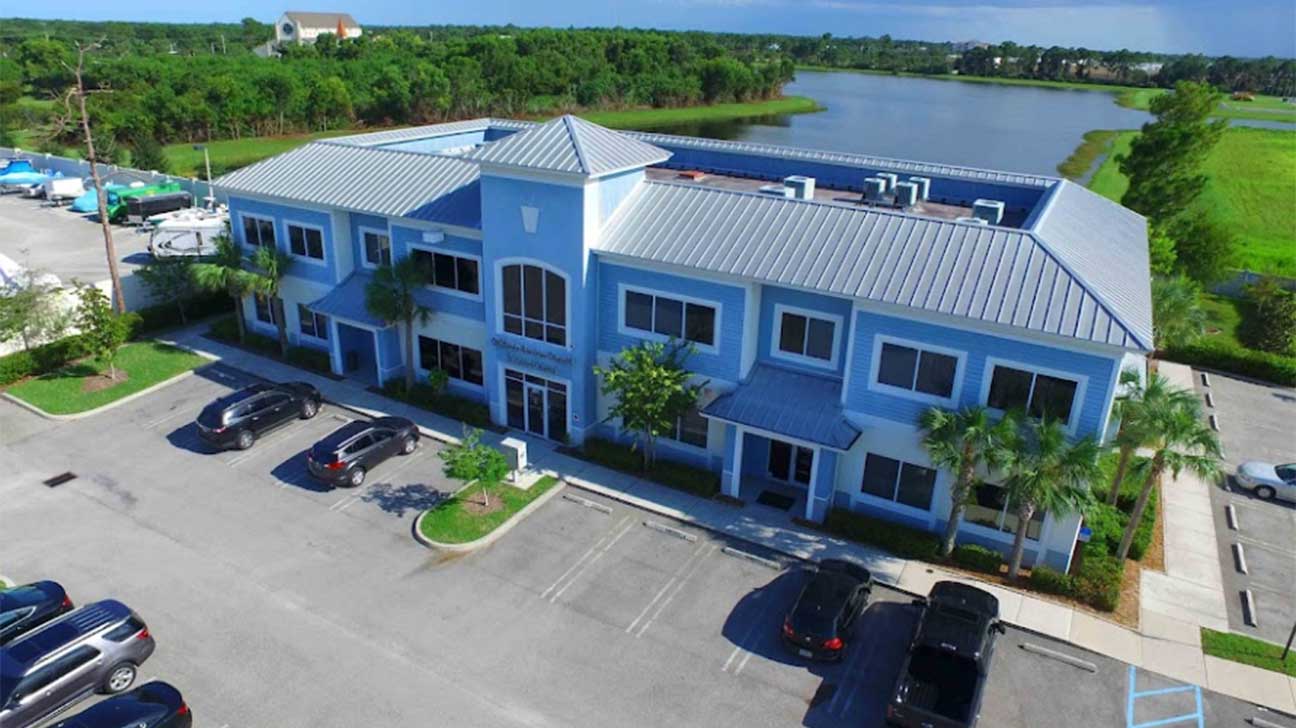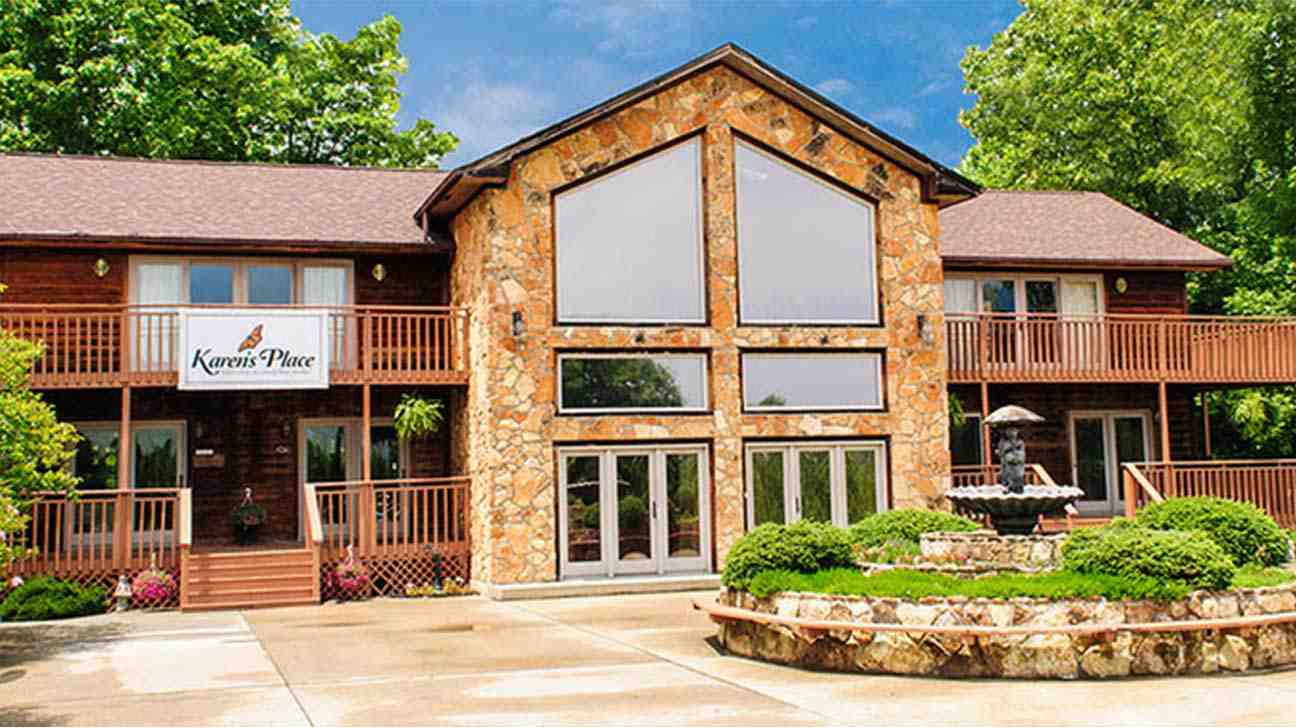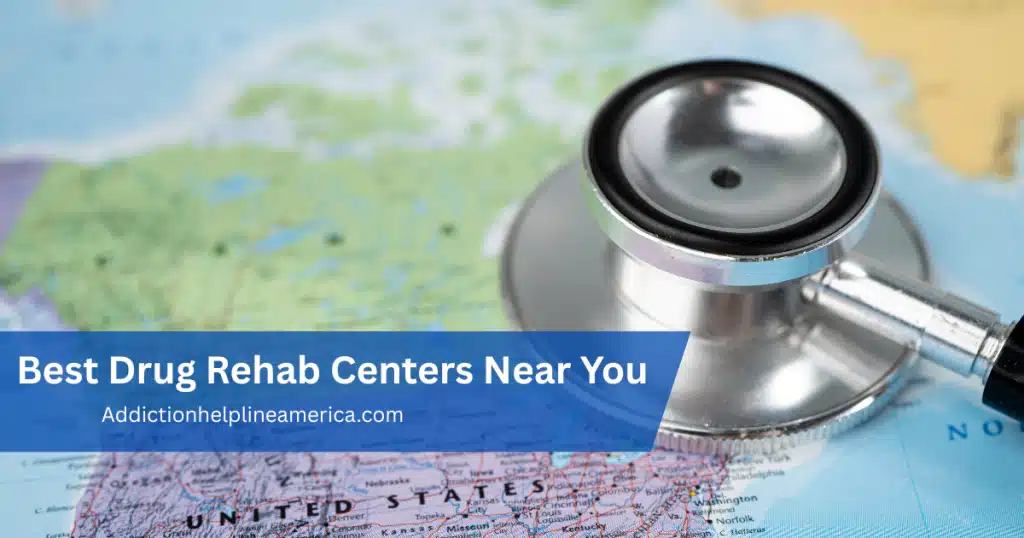
When you find yourself searching for a “drug rehab inpatient near me,” know that you’re taking a massive, courageous step. The key is to cut through the noise online and find a place that’s right for you or your loved one. It’s about more than just finding a building; it’s about finding a safe, structured environment that genuinely supports long-term recovery.
Getting Started: How to Find Inpatient Rehabs in Your Area
Looking for a local inpatient rehab can feel overwhelming at first, but breaking it down into a few clear actions makes it much more manageable. The goal right now is just to build a list of possibilities.
I always tell people to start with the professionals they already trust. Your primary care doctor, a therapist, or a counselor often has connections to reputable treatment centers nearby. They’ve likely referred other patients before and can give you a solid, trusted starting point, which is invaluable.
At the same time, you’ll want to look online, but you have to be smart about it. A quick search will throw a lot at you—some are real treatment centers, but many are just third-party referral sites. A legitimate facility’s website will be transparent. Look for a physical address, staff bios, details about their specific programs, and clearly displayed licenses and accreditations. If a site is vague and just funnels you to a generic hotline without telling you who they are, be cautious.
Does Staying Close to Home Really Matter?
Choosing a rehab that’s close to home has some very real, practical benefits. The biggest one, in my experience, is the ability to involve family. When your support system is just a short drive away, they can more easily join family therapy sessions, which are often a game-changer for recovery.
Being local also means you start building your recovery network right in your own community before you even finish the program. This makes the transition back to daily life smoother because you already have sober connections and support in place. For more on this, check out our guide to finding the right rehab in your neighborhood.
“A supportive environment is one of the most critical factors in sustained recovery. By choosing a local facility, you are not just entering a program; you are beginning to build a recovery ecosystem that will be there for you long after treatment ends.“
Understanding Different Inpatient Programs
Not all inpatient rehab is the same. The length of stay and the intensity of the program can vary quite a bit, so it’s good to know what the options are.
Here’s a quick overview of the different inpatient rehab models to help you understand what’s available.
Types of Inpatient Rehab Care at a Glance
| Inpatient Program Type | Typical Duration | Best Suited For |
|---|---|---|
| Traditional 28-30 Day | 28-30 days | Individuals with less severe addiction or those with significant work/family obligations who can’t commit to a longer program. |
| 60-Day Program | 60 days | People who need more time to address underlying issues and establish new, healthy habits after detox. |
| 90-Day Program | 90 days | Considered the “gold standard” for many, especially for those with severe, long-standing addiction. Offers the most time to heal. |
| Long-Term Residential | 6 months to over a year | Best for individuals with chronic relapse history, dual diagnosis, or those needing a highly structured, sober living environment for an extended period. |
This table shows that while 30-day programs are well-known, longer stays are often what’s needed for lasting change. The key is finding a program that matches the individual’s specific situation.
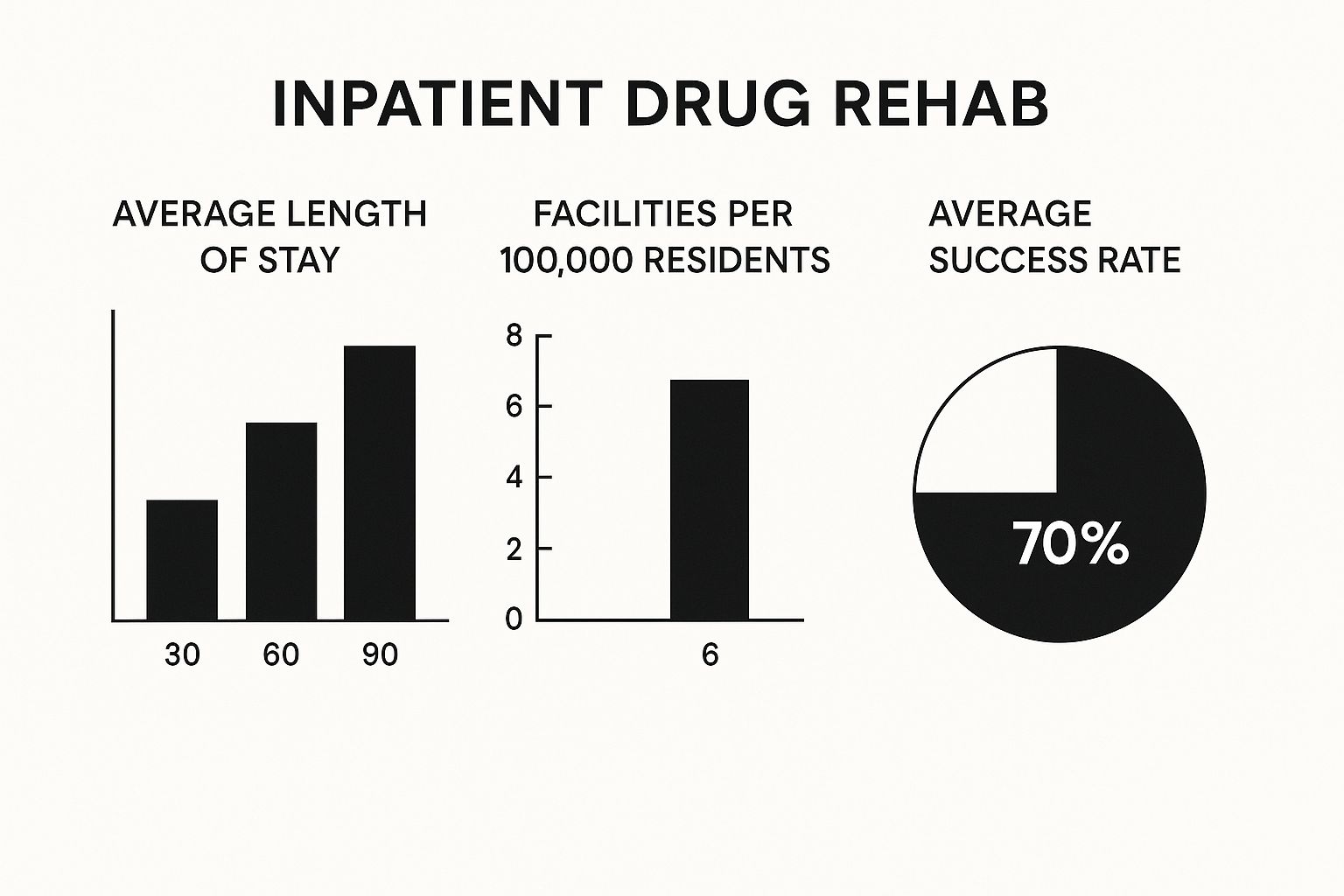
The need for these services is growing fast. The U.S. addiction treatment industry was valued at $2.44 billion in 2024 and is expected to keep expanding. This growth is a direct response to the rising number of people struggling with substance use, which just goes to show how essential these facilities are.
How to Evaluate Treatment Methods and Therapies
Let me be blunt: a one-size-fits-all model is a major red flag in addiction treatment. Everyone’s journey into addiction is different, so their path out must be, too. The goal is to match the program to the person, not the other way around. A center that pushes a single, rigid method might not have the tools to handle the real-world complexities of substance use, especially when mental health issues are involved.
Getting familiar with the core types of therapy will give you the confidence to ask sharp questions and pick a center that genuinely fits.
Key Therapeutic Models to Know
Walking into this, you’ll hear a lot of acronyms and therapy-speak. Don’t let it intimidate you. Most top-tier programs are built on a foundation of “evidence-based practices”—therapies that have been scientifically researched and proven effective for treating addiction.
You’ll most often see these two heavy hitters:
- Cognitive Behavioral Therapy (CBT): This is all about breaking down and rebuilding thought patterns. CBT helps people pinpoint the self-destructive thoughts that lead to using. For example, a therapist helps a client challenge the thought, “This day was awful, a drink is the only thing that will help,” and develop healthier ways to cope with stress instead.
- Dialectical Behavior Therapy (DBT): While it was first designed for other conditions, DBT has become a powerhouse for addiction treatment. It’s incredibly practical, teaching skills in four key areas: mindfulness, managing distress, regulating emotions, and effective communication. These are the exact skills someone needs to navigate cravings and rebuild a stable life.
Good programs often blend these with other valuable methods. For a closer look at what’s out there, you can learn more about the different types of addiction therapy and see how they work in practice.
Does the Center Treat the Whole Person?
Here’s something I can’t stress enough: addiction rarely shows up alone. It’s almost always tangled up with other mental health conditions like depression, anxiety, or trauma. In the industry, we call this a dual diagnosis or a co-occurring disorder, and it’s one of the most critical factors to look into.
“A program that can’t treat both an addiction and an underlying mental health issue at the same time is only doing half the job. Untreated anxiety is a powerful relapse trigger. So is unresolved trauma.”
This is a question you need to ask directly. “Do you have licensed staff to diagnose and treat co-occurring mental health disorders?” A quality center won’t hesitate. They’ll tell you about their on-staff psychiatrists, psychologists, and licensed therapists who specialize in this kind of integrated care.
The data backs this up. While only about 18% of facilities offer longer residential stays (more than 30 days), the results are undeniable. Studies show that between 85% and 95% of people who stick with these comprehensive programs are still drug-free nine months down the line. It’s a powerful testament to how vital an immersive, holistic approach is for building a lasting recovery.
Call Now – Your Journey to Recovery Begins Today!

Take the first step towards a healthier life! Call now to connect with our compassionate team and start your recovery journey today. Your path to healing awaits!
Our recovery specialists are available 24/7 to provide support, and all calls are confidential and free. Reach out anytime – we’re here to help!
Checking Credentials and Staff Qualifications
Think of it this way: you wouldn’t buy a house without checking the foundation, right? Credentials and staff qualifications are the foundation of effective treatment. Any legitimate drug rehab inpatient near me will have them, and they aren’t just for show. They’re proof that the center meets strict standards for safety, care, and ethics. This step is a deal-breaker.
Confirming a Facility Is Legitimate
First things first: state licensing. Every single state has a regulatory body that oversees addiction treatment centers. A facility absolutely must be licensed by the state to operate legally. You can usually confirm this on your state’s department of health or substance abuse services website. If a center isn’t licensed? Cross it off your list. No exceptions.
After that, you want to look for accreditations from national organizations. These are the gold standard and signal a true commitment to excellence. The two heavy hitters you want to see are:
- The Joint Commission: You might know them for accrediting hospitals, but they also give a “Gold Seal of Approval” to behavioral health organizations. This means the facility meets incredibly high standards for patient safety and quality of care.
- CARF International (Commission on Accreditation of Rehabilitation Facilities): A CARF seal means the organization is laser-focused on providing services that deliver the best possible results for the people they serve.
You can usually hop onto The Joint Commission or CARF websites and verify a facility’s status yourself. It takes five minutes and gives you invaluable peace of mind.
Evaluating the Clinical Team
A center’s credentials are one half of the equation; the quality of its staff is the other. You need a team with the right blend of medical and therapeutic expertise, and any good facility will be transparent about who is on their team and what their qualifications are.
A well-rounded professional team should include:
- Medical Doctors (MD) or Nurse Practitioners: This is especially critical for a safe medical detox and for managing any co-occurring physical health problems.
- Licensed Therapists: Look for credentials like Licensed Clinical Social Worker (LCSW) or Licensed Professional Counselor (LPC). These are the pros trained to handle the complex mental health issues that often go hand-in-hand with addiction.
- Certified Addiction Counselors: These specialists, often with certifications like Certified Alcohol and Drug Counselor (CADC), live and breathe the nuances of substance use disorders.
“The people guiding your recovery journey are everything. An experienced, licensed, and compassionate team is the difference between a program that simply gets you sober and one that teaches you how to stay sober.”
This emphasis on professional care is a growing global priority. While demand can shift, the worldwide addiction rehab market is projected to hit $31.3 billion by 2032. This growth shows just how critical structured, professional care is in fighting addiction. You can dig deeper into the rehab services and related statistics to see the trends. Asking tough questions about the staff is how you make sure the care you or your loved one receives is truly top-tier.
Let’s be honest—the conversation about money can be one of the biggest hurdles when you’re trying to find help. It’s stressful, and it can feel like a massive roadblock. But it doesn’t have to be. Getting a handle on rehab costs and figuring out how your insurance plays into it can make the whole process feel much more manageable.
We need to take the mystery out of the financial side of things. When you start searching for a drug rehab inpatient near me, you’ll see that costs are all over the map, depending on where the center is and what they offer. The good news? Many people are shocked to find out just how much their insurance will actually cover. The trick is to be proactive and ask the right questions from the get-go.
Figuring Out Your Insurance Coverage
Your first move should be to call your insurance provider. Don’t just ask a vague question like, “Do you cover rehab?” That won’t get you the details you need. You’re looking for specifics to build a clear financial picture.
Grab a notepad and get ready to ask some direct questions. When you call the member services number on your insurance card, be prepared to dig in.
Here’s what you need to find out:
- What, specifically, is my coverage for residential or inpatient substance abuse treatment?
- Is medical detoxification covered? Sometimes this is billed separately.
- What’s my annual deductible, and how much have I already paid toward it this year?
- What is my out-of-pocket maximum? This is the most you’ll have to pay in a calendar year.
- Does the facility need a pre-authorization before I’m admitted? If so, who handles that—me or the rehab center?
Getting solid answers here is crucial. It takes the guesswork out of the equation and gives you a real budget to work with. For a more detailed breakdown of this process, check out this guide on how your insurance might cover drug rehab.
Key Takeaway: “Thanks to the Affordable Care Act (ACA), most health plans are required to cover treatment for substance use disorder. It’s considered an essential health benefit, so there’s a good chance you have more coverage than you realize.”
Call Now – Your Journey to Recovery Begins Today!

Take the first step towards a healthier life! Call now to connect with our compassionate team and start your recovery journey today. Your path to healing awaits!
Our recovery specialists are available 24/7 to provide support, and all calls are confidential and free. Reach out anytime – we’re here to help!
What If Insurance Doesn’t Cover It All?
So, what happens if your coverage is limited, or if you don’t have insurance at all? Don’t let that stop you. This is a common situation, and quality treatment is absolutely still possible. Many facilities are dedicated to helping people find a way to make it work, regardless of their financial situation.
When you talk to the admissions staff at a potential facility, ask them about these alternatives:
- Sliding Scale Fees: Some centers will adjust the cost of treatment based on your income. You’ll likely need to show pay stubs or tax returns, but this can dramatically lower the price.
- Payment Plans & Financing: It’s common for private rehabs to offer their own payment plans or to work with medical lending companies. This lets you break down the cost into monthly payments you can actually handle.
- State-Funded Programs: Every state gets government funding to offer addiction treatment to residents who can’t afford it. There are usually eligibility requirements, but they are an incredible resource to look into.
- Grants and Scholarships: Believe it or not, there are non-profits and government organizations like SAMHSA (the Substance Abuse and Mental Health Services Administration) that offer grants and scholarships to help people pay for rehab.
The sticker price for inpatient care without insurance can be intimidating, often ranging anywhere from $5,000 to well over $80,000, based on how long you stay and the intensity of the program. But by being resourceful and exploring all your options, you can find the help you need without letting the cost stand in your way.
Getting Ready for Rehab and Your First 72 Hours

Once you’ve made the difficult but crucial decision on a rehab center, the next step is actually getting there. This part of the journey starts with a pre-admission call with an admissions coordinator. It’s a detailed conversation, so be prepared to talk openly about your history with substance use, your mental health, and any physical health issues you have.
This isn’t just a formality. The honesty you provide here is what the clinical team uses to build your initial care plan and ensure your detox process is as safe as possible. After the call, they’ll tell you exactly what paperwork to bring—usually a photo ID, insurance card, and maybe some medical records. Getting these together ahead of time makes the check-in process go much more smoothly.
What to Pack and What to Leave at Home
Packing for rehab is all about intentionality. You’re bringing the essentials to keep you comfortable and focused, while leaving behind anything that could distract from your recovery. Every center has its own specific list, but a good general guideline is to pack about a week’s worth of simple, comfortable clothing.
- Comfortable Clothes: Think sweatpants, t-shirts, sweaters, and anything else you can relax in. Make sure nothing has logos or graphics related to drugs or alcohol.
- Hygiene Products: Bring new, unopened, and alcohol-free toiletries. This is a standard rule for things like shampoo, soap, deodorant, and toothpaste.
- Important Paperwork: Keep your ID, insurance card, and a small amount of cash for vending machines in a single folder.
- A Journal and Pen: You’ll be processing a lot of new information and emotions. Writing it all down can be incredibly therapeutic.
Most centers have a strict policy against bringing items like cell phones, laptops, tablets, or outside food and drinks. This isn’t to punish you; it’s to create a protective bubble where you can fully immerse yourself in the healing process without outside triggers. For a deeper dive into these first steps, you can learn more about what to expect in rehab and how to prepare.
“The first few days are about surrendering to the process. You are building a new foundation, and that begins with letting go of old comforts and trusting the structure designed to help you heal.”
The First Three Days: Settling Into a New Reality
The first 72 hours in rehab are an intense period of adjustment. You’ll probably feel a whole spectrum of emotions, from relief and hope to fear and anxiety. That’s completely normal, and everyone there understands. Your first day will be a whirlwind of intake procedures. This includes a comprehensive medical evaluation and a deeper psychological assessment to finalize your personalized treatment plan.
If detox is part of your plan, it will start almost immediately. You’ll be under 24/7 medical supervision to ensure your withdrawal symptoms are managed safely and with as much comfort as possible. The medical staff is there solely to help you get through this initial, difficult phase.
During these first couple of days, you’ll also get introduced to the daily schedule. This routine is one of the most powerful aspects of early recovery. It might feel jarring at first—waking up early, attending different therapy groups, meeting one-on-one with your counselor, and maybe doing some wellness activities like yoga or meditation. This structure is designed to replace the chaos of addiction with predictability, purpose, and healthy habits. You’ll meet the staff, get to know the other people in your program, and begin laying the groundwork for a new life.
Answering Your Final Questions About Local Inpatient Rehab
As you get closer to choosing a rehab, a few practical questions almost always come up. Think of this as the final checkpoint. Getting solid answers to these common concerns is often what gives people the confidence to finally pick up the phone and commit.
How Long Will I Actually Be in Rehab?
There’s no magic number for how long an inpatient stay should be; it’s all about what you personally need to get a strong start in recovery. Most facilities you’ll find offer programs in 30, 60, or 90-day increments. A 30-day stay can be a great option for someone to get stable, go through detox safely, and start building some foundational coping skills.
But for individuals with a longer or more severe history with substance use, a longer stay is almost always the better bet. Those extra weeks in a 60 or 90-day program are invaluable. It’s more time to dig into the real issues behind the addiction and, just as importantly, more time to practice living sober in a completely safe and supportive space. Any good facility will do a thorough assessment upfront to help figure out the timeline that gives you the best shot at lasting recovery.
Can My Family Visit Me?
Family can be your biggest ally in recovery, and good rehabs know this. Most centers welcome family involvement with things like scheduled visiting hours or dedicated family therapy weekends. But, it’s important to know that almost every program has an initial “blackout” period.
This quiet time usually lasts for the first 7 to 14 days. It’s not a punishment; it’s a purposeful boundary designed to give you the space to settle in, focus completely on yourself, and get through the toughest early days without distractions. Once you’re past that initial phase, visits and phone calls are typically encouraged. Make sure to ask about the specific family policy at any center you’re considering, as it can make a big difference.
Key Insight: “Understanding how a loved one can offer support is just as important as the treatment itself. For families navigating this process, it’s helpful to learn how to help someone with addiction in a constructive, supportive way.”
Call Now – Your Journey to Recovery Begins Today!

Take the first step towards a healthier life! Call now to connect with our compassionate team and start your recovery journey today. Your path to healing awaits!
Our recovery specialists are available 24/7 to provide support, and all calls are confidential and free. Reach out anytime – we’re here to help!
What Happens When I’m Done With the Program?
Recovery is a journey, not a destination. A high-quality rehab program doesn’t just end on the day you’re discharged. Before you leave, the clinical team should sit down with you to create a detailed aftercare plan. This is your personalized roadmap to staying sober when you return to your daily life.
A strong aftercare plan is designed around your specific situation and environment. It will likely include:
- Step-Down Care: This might mean transitioning to a Partial Hospitalization Program (PHP) or an Intensive Outpatient Program (IOP), which offer structured support while you live at home.
- Support Groups: You’ll get connected with local 12-step groups like AA or NA, or other peer-led networks like SMART Recovery.
- Sober Living Options: If returning home isn’t the safest option, the team will recommend vetted sober living homes to provide a structured, substance-free environment.
- Continued Therapy: They’ll help you find a therapist or counselor in your community to continue the personal work you started in treatment.
The whole point is to make sure you have a safety net in place. You’re building a new support system that will be there to catch you as you face the real world again.
At Addiction Helpline America, we’re ready to help you sort through any of these questions and more. Our team is here 24/7 for a confidential chat to guide you toward the right treatment. Contact us today and let’s take that first step together.
Our helpline is 100%
free & confidential
If you or someone you care about is struggling with drug or alcohol addiction, we can help you explore your recovery options. Don’t face this challenge alone—seek support from us.
Programs
Resources
Will my insurance
cover addiction
treatment?
We're ready to help
Find the best
drug or alcohol treatment
center
Are you or a loved one struggling with addiction? Call today to speak to a treatment expert.




